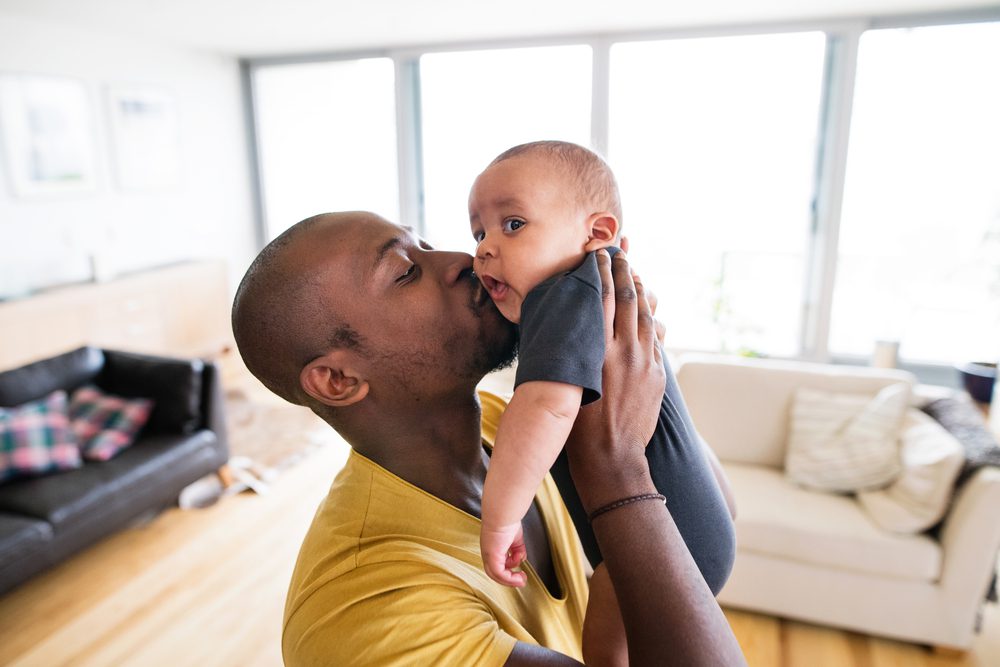Social-emotional wellness is often known as infant mental health by early childhood professionals. In a nutshell, it is developing the capacity to experience and regulate emotions, form secure relationships, and explore and learn.
Relationships are the way babies come to know the world and their place in it. They provide the loving context necessary to comfort, protect, encourage, and offer a buffer against stressful times. It is through relationships that young children develop social emotional wellness, which includes the ability to form satisfying relationships with others, play, communicate, learn, face challenges, and experience emotions. In addition, nurturing relationships are crucial for the development of trust, empathy, compassion, generosity, and conscience.
To learn more, browse our tips on promoting children’s healthy social-emotional development from birth to three.
Provide Your Child With Responsive Care
 Elaine is feeding her 8-month-old daughter Jessica some cereal. Jessica grabs the spoon out of her hand and proceeds to feed herself. Elaine almost grabs the spoon back, but instead, waits to see what will happen next. Jessica’s try at feeding herself is a little slow, and very messy, but she manages to get a few spoonfuls into her mouth. Elaine sees that Jessica is really involved in trying to feed herself, and also notices that Jessica is not actually getting too much food in her mouth. Her solution? She gets another spoon, and offers Jessica cereal herself to supplement her daughter’s efforts.*
Elaine is feeding her 8-month-old daughter Jessica some cereal. Jessica grabs the spoon out of her hand and proceeds to feed herself. Elaine almost grabs the spoon back, but instead, waits to see what will happen next. Jessica’s try at feeding herself is a little slow, and very messy, but she manages to get a few spoonfuls into her mouth. Elaine sees that Jessica is really involved in trying to feed herself, and also notices that Jessica is not actually getting too much food in her mouth. Her solution? She gets another spoon, and offers Jessica cereal herself to supplement her daughter’s efforts.*
What Elaine did might seem simple, but it can be pretty hard. It takes time to slow down, and carefully look at, or observe, what your child is doing, in order to learn what the behavior might mean. In this case, Jessica was saying, “Hey, I want to try to feed myself with a spoon! I can do it!” Elaine had to be willing and able to take the time, put up with some mess, and find a way to respond to Jessica’s needs both for food (nutrition for her body) and for a chance to try something new (nutrition for her mind).
How often do you observe what your child is doing? Sounds like a silly question with the answer being, “I watch him all the time!” However, we often are with our children without really observing them. Observing involves looking at what your child is doing, listening to what he is saying, and learning about your child’s individual way of approaching the world (is he a jump in and “let’s go” child or a sit back and “take it slow” child; is he a “high reactor” who let’s you know how he feels when he feels it or a “low reactor” who’s pretty laid back, etc.). Taking time to really sit and observe what children do can tell us a lot. It provides us with clues about what makes our child tick. Those clues allow us to make better educated guesses about why they behave as they do, and help us as parents and caregivers to respond in a way that is productive and supports their development. When children feel responded to and understood, they develop confidence and good self-esteem.
Be Affectionate and Nurturing
Sonya scoops little Jacob out of the tub. “You smell so good! What a pretty baby you are!” she says as she wraps him in a soft, warm towel and gives him a hug. Jacob squeals with delight and then snuggles down into mom’s arms. Bath time is so much fun—where else can you splash and play each day in a big puddle with toys and all of the attention focused on you?! Jacob loves his time in the tub where he has a ball playing and where mom takes care of keeping him safe and getting him clean. He knows he is safe and special to this person he trusts so much.
The sight of a cute baby makes us want to coo, gurgle, and entertain to get that wonderful baby smile. Feelings of affection can be a little more hard to come by during prolonged crying spells or tantrums—but fortunately, most of us can find our feelings of love and desire to nurture little ones even during trying times. Touching, holding, comforting, rocking, singing and talking to babies are things that may seem to be the natural way to play with a baby or to comfort a distressed young child. These interactions are more than meets the eye—they also provide precisely the stimulation their growing brains need. Loving touches and encouraging words send messages to your baby that he is somebody special. And when he feels he is loved for who he is, he learns how to love others that way, too.
Help Your Child Learn to Resolve Conflicts in a Healthy, Appropriate Way
 Teddy and Brian, both 2-year-olds, love the book area of their day-care. Teddy picks up a big book about dinosaurs. When Brian sees this neat book, he can’t help himself—he wants it, too! So he grabs it from Teddy. Uh-oh, a battle is now underway with “Mine”, “No! Mine!” and a few tears. Miss Kelly steps over to help the boys. “Brian, I know you like the dinosaur book and you are sad, but Teddy was playing with it. It’s not nice to grab it from him and make him cry. How about if we look at it together? I’ll hold the book, Teddy can turn the page, and you can make the “Roar” sound when we get to the big dino page!”*
Teddy and Brian, both 2-year-olds, love the book area of their day-care. Teddy picks up a big book about dinosaurs. When Brian sees this neat book, he can’t help himself—he wants it, too! So he grabs it from Teddy. Uh-oh, a battle is now underway with “Mine”, “No! Mine!” and a few tears. Miss Kelly steps over to help the boys. “Brian, I know you like the dinosaur book and you are sad, but Teddy was playing with it. It’s not nice to grab it from him and make him cry. How about if we look at it together? I’ll hold the book, Teddy can turn the page, and you can make the “Roar” sound when we get to the big dino page!”*
Around this age, toddlers are developing an awareness of “self” and sharing can be especially hard. They know what they want when they want it, but their brains are not yet fully capable of understanding another person’s feelings or point of view. In addition, self-control is also just beginning to develop. Though toddlers can understand what you mean when you say not to take something from others, they have a hard time keeping themselves from acting on their impulses. Think how hard it can be for you, as a mature adult, to stop yourself from eating that chocolate chip cookie you are craving when you have decided to go on a diet.
Adults’ impulse control gets tested from time to time; for toddlers the test occurs many times a day. The ability to exercise greater self-control comes with time, brain maturation, practice, and with the help of caring adults. By helping very young children name their feelings, and letting them see and practice ways to control their impulses, they learn over time how to do it themselves. This helps them learn how to resolve conflicts on their own.
Here are some ways you can help them control their urges and resolve conflicts:
Five-month-old Jeremy is laying on his tummy playing on the floor at home. He reaches across the blanket he’s on for the squeaky duck toy. It is just out of his reach. His dad begins to pick it up and give it to him, but realizing Jeremy isn’t fussing, he decides to wait a second. Jeremy is determined to get that duck! He stretches his hand again and this time barely touches it. His dad gives the duck just enough of a nudge to provide Jeremy a little help. One more reach…Got it! Jeremy grabs the duck toy and happily begins squeeking it himself.*
Jeremy’s dad just practiced a concept many child development specialists call “scaffolding.” Scaffolding happens when you follow your child’s lead and provide just enough support to challenge him to the next level without overwhelming him with frustration. Jeremy’s dad could have handed the toy to his son, but he stopped, looked, and thought about what Jeremy was doing. Jeremy was trying out his big and small muscles and seeing what he could do. He was also learning about what he would need to do to get something he wanted. Jeremy’s dad realized he could let Jeremy explore the situation a little and then provide just enough help to let him experience the success of using his new skills of reaching and grabbing. Helping babies learn in this way lets them explore what they are capable of doing and also lets them know you are there to support their efforts.




